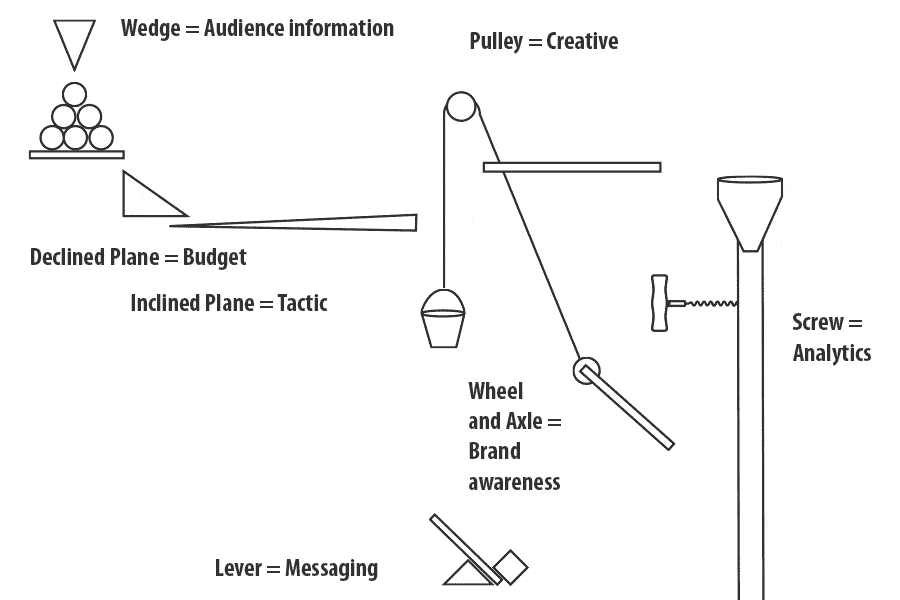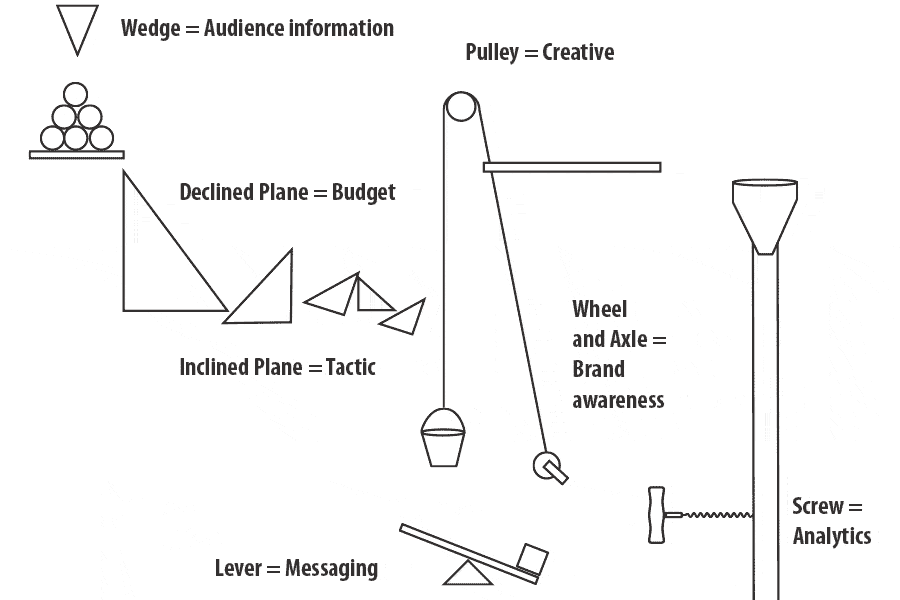As a marketer (eek) and a designer (even worse) who often works with engineers, I routinely discover a couple of things I believe to be true for that particular group of people. 1. They are pretty sure they are smarter than me, and 2. They believe that just because a thing should work, that it will work. That concept is likely often true in engineering (even if the best/most interesting engineers tend to employ a test, learn, refine approach), but it is rarely true in marketing. Especially if the one doing the believing has a firm grasp of mechanical principles, but a shaky-at-best understanding of actual human behavior.
FIG. 1 – Keep reading to find out what it’s doing here.

With all of that in mind I set out to explain the vagaries of marketing in terms more easily understandable to a mind that is programmed by years of study to make a linear process out of everything, no matter how layered.
Extraordinarily tired of hearing “it’s not rocket science” about the work I spend all day doing, I originally started with a comparative equation between extended campaign calculations and, well, your standard rocket math. However, it turns out that standard rocket math is, well, not that difficult on the one hand, and highly specialized on the other. The engineers I work with do not build rockets. For the most part they build systems, or software, or bearings, or winches. Parts of things rather than whole things. And with rockets, the basic calculation of how much fuel it’s going to take to get to space? Well, that’s pretty much the whole thing. That and gravity. So, I decided to start at the beginning and find some correlation between the basic principles of engineering and the basic principles of marketing. That led me back to the idea of the Archimedean simple machines: the wheel and axle, the pulley, the inclined plane, the screw, the wedge, and of course, the lever.
A couple of key principles to remember: Simple machines do not include an energy source so they cannot do more work than they receive from the input force. Simple machines are also subject to friction, which will reduce their overall output. A machine that is subject to friction will not be able to move as large a load as one that is not.
Input force = desire of the company to sell its product and what they are willing to invest to do so.
Friction = the difference between the amount of product a company wants to sell and the amount of people who want to buy it only from them.
Just as it is the purpose of all simple machines to provide a mechanical advantage over gravity when trying to move an object, it is the purpose of marketing to provide a company with a means of more effectively moving an audience from a position of a non-buyer to a position as a buyer.
Let’s start with the wedge. A wedge transports energy and collects it to the pointy end, consequently breaking the item it is used on. Each piece of the object should require less effort to move than the whole object. Think of the wedge as your audience segmentation or customer profile information. This information gives you the means to break the object “everyone in the whole world” into more manageable pieces. Some of these smaller pieces should represent “the people who really want to buy or need our product”. By focusing future input force first on moving these smaller pieces, your marketing can be more successful.
Now the plane. Inclined planes are widely used to move heavy loads over vertical obstacles; examples vary from a ramp used to load goods into a truck, to a person walking up a pedestrian ramp, to an automobile or railroad train climbing a grade. A declined plane is generally used to add input force to an object in order to overcome friction over time. For the purpose of our metaphor we’ll think of declined planes as representative of your marketing budget and inclined planes as the tactics you are able to implement based on that budget. Some tactics may move your object further along its journey than others, but they will either require a greater input force (if they raise your object on a steep vertical) or less input force but a longer time (if they move your object over a longer horizontal distance).
Ah, the pulley, the greatest of simple machines, able to support movement and change of direction and multiply the force applied to it. Try moving a heavy load vertically without it and you’ll quickly find that the activity falls short. Try doing marketing without good, well-thought-out creative, and you’ll find yourself in the same situation.
Next, the lever. You know the famous saying about moving the world with this simple machine. Consider the lever (and the place to stand) as representing your messaging. Capable of moving your audience further and faster along your journey than you think, relevant, compelling messaging applied at the right time is one of the most important keys to marketing.
The wheel + axle is a simple machine composed of two disks, or cylinders, of different diameters mounted so they rotate together around the same axis. Think of a crank or a winch, but unpowered. Power is supplied by applying force to the wheels, causing the axis to spin. Since the wheels are larger in diameter than the axle, the force applied is multiplied. A wheel + axle combo is often combined with another simple machine like a pulley to create a compound machine to further multiply mechanical advantage. The same is true for marketing principles. For example, when the wheel + axle represent brand awareness it is easy to see how messaging, creative, and brand awareness can move your audience further or more quickly along their journey. For example, the greater your brand awareness the more impact your creative and messaging will have on your audience.
And that brings us to our final simple machine, the screw, and our final basic marketing principle of analytics. The screw is best described as a narrow plane wrapped around a cylinder. A screw is generally used to convert rotational motion or force to linear motion or force. In this way it can be used to move an object. In other words, the turning of a screw can be used to move an object on a linear plane. In much the same way analytics can be used to convert information gained by observing the response to tactics into campaign changes, such as budget allocation, which close the distance between your audience and your goal.
Like many concepts, this one is best represented visually. Figure 1 and 2 are animations of two possible scenarios.
Figure 1 represents a marketing campaign with a relatively small budget and limited tactics, a long timeline, some existing brand awareness, and a good audience profile. We are assuming that the creative and messaging is on point, mostly because we’re a creative agency and that’s our job. We will also assume that analytics are in place, because of course they will be.
Figure 2 represents a project with a large budget spread out over several tactics. However, this company is short on brand awareness, meaning that creative, messaging and analytics must do more of the work to achieve similar results.
In both examples, audience information is constant, primarily because this blog is meant to simplify things. If you want to learn more about the impact audience size and specificity can have on a campaign, talking to a creative agency like d.trio is a good place to start.
So, there you have it. I hope this gives you a new way of looking at marketing. Just like engineering, many components need to work together to move things in the desired direction. One defective, missing, or ignored component can bring things to a sudden end.
FIGURE 2 – It should all make more sense now.

Looking for some other marketing and branding resources for manufacturers or manufacturing marketers? Here’s a couple of ours that we think will help:
Tips for manufacturing marketers on creating great content.
Six great tools for marketing teams on a budget.
![cat[&]tonic](https://cat-tonic.com/wp-content/uploads/candt_logo-rw.png)




